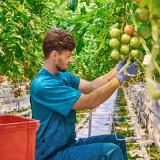
La relazione, che fa parte di una serie annuale sui salari minimi, riassume i principali sviluppi riscontrati nel corso del 2019 e all’inizio del 2020 attorno all’iniziativa dell’UE sui salari equi e pone il dibattito nazionale sulla fissazione delle aliquote per il 2020 e oltre in questo contesto. La relazione illustra il modo in cui sono stati fissati i salari minimi e il ruolo delle parti sociali. Analizza l’evoluzione dei salari minimi legali e presenta dati sui minimi tabellari nei contratti collettivi relativamente a 10 occupazioni a bassa retribuzione nei paesi privi di salari minimi legali. La relazione include anche una sezione sulla dimensione regionale dei salari minimi e presenta le ultime ricerche sugli effetti delle variazioni del salario minimo su salari, occupazione, povertà dei lavoratori, prezzi e utili.
Key findings
Nel 2019 molti paesi hanno discusso un ulteriore e sostanziale aumento dei salari minimi dopo il 2020, in parte rispetto a un obiettivo relativo, in parte in termini assoluti.
I salari minimi legali sono divenuti più equi rispetto ai salari di altri lavoratori dall’inizio del millennio (confrontando i salari minimi legali con i salari mediani di tutti i lavoratori).
Malgrado la tendenza all’aumento, i salari minimi nella maggior parte dei paesi restano inferiori al 60 % o addirittura al 50 % dei salari mediani. Questo vale in particolare per gli Stati membri dell’Europa centrale e orientale, che all’inizio del millennio erano partiti da livelli relativi molto bassi e continuano ad avere obiettivi di circa il 50 % o meno nelle loro normative sul salario minimo.
Complessivamente, sette lavoratori su 10 che percepiscono il salario minimo riferiscono quantomeno una certa difficoltà nell’arrivare a fine mese, rispetto a meno di cinque su 10 degli altri lavoratori; queste cifre variano tuttavia notevolmente da un paese all’altro. Ad esempio, meno del 10 % dei lavoratori che ricevono il salario minimo riferiscono di trovarsi in una situazione da difficile a molto difficile in Danimarca, Finlandia, Germania e Svezia rispetto al 50-60 % in Bulgaria, Croazia e Cipro e all’80 % in Grecia.
I governi in Europa reagiscono con misure di stabilizzazione del reddito per le persone colpite dalla crisi del coronavirus. I salari minimi possono avere un ruolo nel mix delle politiche per stabilizzare i redditi e quindi la richiesta di contrastare una spirale discendente in recessione o depressione.
Data
Find data on statutory minimum wages in the EU.
- Data: Proportion of minimum wage workers who find it difficult to make ends meet, EU average
- Data: Minimum wage developments in real terms, 15 euro area countries, 2015 price levels
- Data: Proportion of minimum wage workers who find it difficult to make ends meet
- Data: Statutory minimum wages - Minimum wages in the EU in 2020
List of tables
- Table 1: Social partners’ first reactions to the announced initiative on fair wages
- Table 2: Overview of main arguments and proposals concerning an EU minimum wage initiative from social partners
- Table 3: Gross minimum wages, selected EU Member States and the UK, 2019 and 2020
- Table 4: Sub-minimum rates for selected EU Member States and the UK as at 1 January 2020
- Table 5: Further statutory minimum wage rates for private sector workers in selected EU Member States
- Table 6: Number of collective agreements covering low-paying job categories for countries without statutory minimum wages
- Table 7: Minimum wages in collective agreements, applicable in 2019 for selected low-paid jobs
- Table 8: Collective agreement coverage in Finland
- Table 9: Overview of debates during 2019 on aspects of the minimum wage setting processes
- Table 10: Demands for and agreements on targets for future minimum wages to address adequacy in selected EU Member States and the UK
- Table 11: Regional statutory minimum wage rates
- Table 12: Latest minimum wage research in EU Member States and the UK
- Table 13: Overview of recent empirical research in the EU, Norway and the UK on employment impacts of minimum wage increases, 2019
- Table 14: Policies influencing in-work poverty
- Table A1: Network of Eurofound Correspondents – Members participating in the research
List of figures
- Figure 1: Conceptualising adequate minimum wages
- Figure 2: Estimated share of employees earning 90% to 110% of the minimum wage, EU Member States, 2017
- Figure 3: Proportions of female and male employees, EU level, 2017
- Figure 4: Proportion of minimum wage workers per sector, EU level, 2017
- Figure 5: Proportion of minimum wage workers per occupation (top 10), EU level, 2017
- Figure 6: Hourly minimum wages, selected EU Member States, 2020
- Figure 7: Minimum wage developments in real terms, 15 euro area countries, 2015 price levels
- Figure 8: Minimum wage developments in real terms, non-euro area, 2015 price levels
- Figure 9: Impact of purchasing power on the minimum wage value for selected EU Member States and the UK, as at 1 January 2020
- Figure 10: Relative distance between purchasing power of lowest and median minimum wage EU Member States and the UK and highest minimum wage EU Member States and the UK, 2010–2020
- Figure 11: Process for determining minimum wage rates for 2020
- Figure 12: Number of minimum wage rate updates, EU Member States with statutory minimum wages and the UK, since 2010
- Figure 13: Longer-term trend of development of statutory minimum wages relative to median wages of full-time employed workers, selected countries within the EU and the UK, 2000–2018
- Figure 14: Proportion of minimum wage workers who find it difficult to make ends meet, EU average
- Figure 15: Proportion of minimum wage workers who find it difficult to make ends meet
- Figure 16: Making ends meet and minimum wages in relative and absolute terms
- Figure 17: Monthly minimum wage as a proportion of the mean value of average monthly earnings by NUTS1 region, reference year 2016
- Figure 18: Regional variation of relative monthly minimum wages, by NUTS1 region, 2016
- Figure 19: Examples of countries with higher interregional differences in the proportion of minimum wage workers
- Number of pages
-
86
- Reference nº
-
EF20005
- ISBN
-
978-92-897-2068-7
- Catalogue nº
-
TJ-AS-20-001-EN-N
- DOI
-
10.2806/999852
- Permalink
Cite this publication
